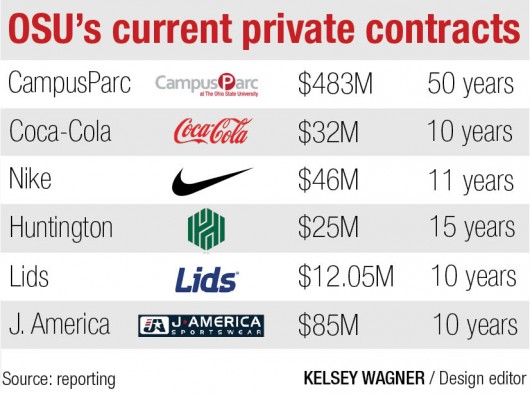In its quest to cut costs and reduce its carbon footprint, Ohio State is looking to privatize the management of its utilities, including water, electricity and gas. And while it’s not the first time OSU has privatized an asset, officials said this also might not be the last.
The effort, dubbed the Comprehensive Energy Management Initiative, would involve entering into a long-term lease with an outside company that would manage the university’s utilities.
That company could then profit by helping OSU cut energy costs and make it more energy efficient — something Provost and Executive Vice President Joseph Steinmetz said OSU can’t easily do on its own.
“Through these kinds of opportunities, we might be able to generate revenue that we can then just plug into the sustainability efforts that we want,” Steinmetz said in a Wednesday interview with The Lantern. “The asset-generated revenue also could be plugged into student support and faculty help as well.”
OSU currently spends $100 million annually on energy, said Geoff Chatas, senior vice president and chief financial officer. It also has about $250 million to $300 million worth of energy improvements that could be made, but haven’t because of a lack of funding.
OSU would spend the early part of 2015 assessing which companies might be fit for the job, Chatas said. Bidding could then start as early as next fall. The duration of the lease and the amount OSU might save depends on what the companies propose.
Still, Steinmetz said it’s unclear if the initiative — which was announced to the University Senate Fiscal Committee Tuesday — could result in people losing their jobs.
“Changes in either plus or minus on positions could happen,” Steinmetz said. “It depends on what the final proposal actually looks like.”
Although Steinmetz said it’s too early to consider employee reductions, Chatas said the money OSU might gain from the deal could create jobs.
But this isn’t the first, and perhaps not the last, time OSU has sought to gain capital from privatization.
The university agreed to a 50-year lease on its parking assets for the upfront price of $483 million. QIC Global Infrastructure, an Australian investment firm, placed the bid and created CampusParc to operate the parking facilities. The deal was finalized and approved by the Board of Trustees in June 2012. That deal was criticized by people — including faculty — at the time and has been criticized since for the annual price increases it permits.
- OSU also holds private contracts with other companies:
- Coca-Cola: a $32 million contract spanning 10 years that makes Coca-Cola the exclusive beverage vendor at OSU
- Nike: $46 million over 11 years that makes Nike the exclusive supplier of any athletic equipment used by OSU varsity athletes and gives the company licensing rights on OSU retail apparel
- Huntington: 15-year, $25 million contract that makes Huntington the official consumer bank of OSU
- Hat World Inc., doing business as Lids Sports Group: 10-year contract worth $12.05 million that gives the company, with J. America, the right to exclusively produce and sell university apparel
- J. America: 10-year, $85 million contract that gives the company, with Lids, the right to exclusively produce and sell university apparel
Steinmetz said he has no qualms about privatizing other things going forward.
“From my perspective, I don’t think anything should ever be off the table,” he said. “If there’s a way we can do it more efficiently, if there’s a way we can transfer the money that we’re overspending on something to support students in our academic mission, then that’s the academic officer in me coming out.”
Still, Steinmetz said there’s been little talk of privatizing anything else at the moment, and that current efforts, like privatizing utilities, are the university’s main focus right now.
“We’ll look at all things that are possible that may be out there — we haven’t looked at any of these in specific, like dining I’ve heard come up a couple of times — and that’s not something at this point that we’ve said, ‘Yeah, let’s go look at it,’” he said.
And while the latest privatization is still at least a year away, Steinmetz said from his perspective, faculty have so far been on board.
“I’m sensing a bit of excitement about this,” he said. “I think everyone understands the enormous issue and problem it is with a campus this large — this many working parts, the buildings, the age that they are — of accomplishing something significant of the sustainability side and I think what the faculty realize — and students, by the way, too — is this, in a lot of ways,is a long-term investment as well.
“We’re trying to do things right now so that 30 and 40 years from now we are still reaping the benefits of having reduced our footprint and having reduced our cost as it comes to energy.”
At least one faculty member said he thinks privatizing utilities might prove helpful for the university.
“There is a potential benefit here that really has everyone involved,” said Richard Dietrich, a professor at OSU’s Fisher College of Business and chair of University Senate’s Fiscal Committee. “We can improve the energy efficiency of our buildings and we can potentially reduce the cost of energy that we use on this campus by reducing the amount of energy we use on this campus.”
Dietrich — who said he’s known about the initiative for about a year — said he didn’t have any outstanding reservations when he was first informed of the plan.
“I think that the process is very well thought out, including making people aware at an early stage what we’re doing,” he said.



